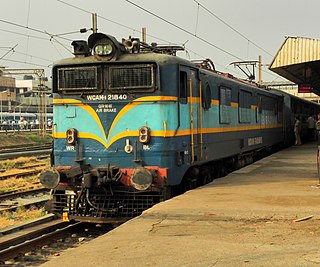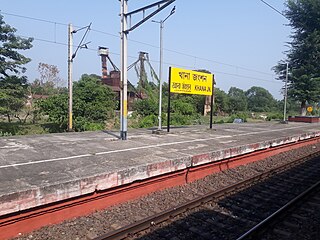
The Indian locomotive class WAP-7 is a class of 25 kV AC electric locomotives that was developed in 1999 by Chittaranjan Locomotive Works (CLW) for Indian Railways. The model name stands for broad gauge (W), AC Current (A), Passenger traffic (P) engine, 7th generation (7). They entered service in 2000. A total of 1351 WAP-7 have been built, with more units being built at CLW, Banaras Locomotive Works (BLW) and Diesel-Loco Modernisation Works (DLMW).

The Indian locomotive class WAM-4 is a class of 25 kV AC electric locomotives that was developed in the 1970 by Chittaranjan Locomotive Works for Indian Railways. The model name stands for broad gauge (W), alternating current (A), mixed traffic (M) engine, 4th generation (4). They entered service in March 1971. A total of 500 WAM-4 were built at CLW between 1970 and 1983, which made them the most numerous class of mainline electric locomotive till its successor the WAG-5.

Vadodara Junction railway station is the main station in the Indian city of Vadodara, Gujarat. It is the ninth-busiest railway station in India in terms of frequency of trains after Kanpur Central, Vijayawada Junction, Delhi Junction, New Delhi, Ambala Cant, Howrah, Patna Junction and Asansol Junction and busiest in Gujarat state and as well as a major stop on the Western Railway zone of Indian Railways. Around 170 trains start, end, or pass through the station daily.

The Indian locomotive class WCAM-1 is a class of Bi-current electric locomotives that was developed in the 1972 by Chittaranjan Locomotive Works for Indian Railways. The model name stands for broad gauge (W), DC Current (C), AC Current (A), Mixed traffic (M) locomotive, 1st generation (1). They entered service in March 1973. A total of 54 WCAM-1 were built at CLW between 1973 and 1979, which made them the most numerous class of mainline dual-power AC-DC electric locomotive.

WCAM-2 is a class of locomotives used in the Indian Railways system. They are the second locomotive from the WCAM class. The model name stands for broad gauge (W), DC Current (C), AC Current (A), Mixed traffic (M) locomotive, 2nd generation (2). They use the same motors as WCAM 1 but with different circuitry and gearing. They are operational in routes around Mumbai. MU operation was possible with 3 units. WCAM-2P was the passenger-oriented version of the WCAM-2 class. However, they perform better than the WCAM 1 series. Same as WCAM 1 class they also performed poorly in DC mode compared to AC mode. They were also used for hauling trains away from the DC section of suburban trains to AC section and performed the same task as the WCAM-1 did. WCAM-2 locos had the same traction motors, as the WCAM-1 locos, but different circuitry and gearing. The bogies are somewhat different from those of the WCAM-1 being fabricated trimount Co-Co bogies with secondary suspension. Rated speed 105 km/h in DC mode and 120 km/h in AC mode.. Almost all of these were dual-braked, but all are now equipped with air brakes only. All the WCAM-1's and -2's were homed at Valsad shed in Gujarat. Many of CR's WCAM-2 locos were not used much in DC zones as they delivered very poor performance in DC mode and on CR's heavy grades. Although these locos have the same traction motors as the WAM 4 and WCAM 1, the power output from the WCAM-2 locos is higher than for the WAM-4 and WCAM-1 because in those models the traction motors were underfed and did not yield their potential maximum power. Under AC traction, the WCAM-2 locos operate with all six motors in parallel, while in DC mode they also operate in the all-series and series-parallel configurations. Recent WCAM-2's from BHEL, including the passenger-specific version WCAM-2P, were rated 2900 hp in DC mode and 4700 hp in AC mode. These were used by WR and CR for fast trains, running at up to 120 km/h. CR had tried the WCAM-2 and WCAM-2P units but found them usable only with speed restrictions. Some WCAM-2P units had only air brakes. With the WCAM-2 locos, MU operation was possible with up to 3 (4?) units. Some (all?) of the WCAM-2 locos were originally leased to IR, ownership remaining with BHEL, the manufacturers.

Asansol Junction railway station is a Division of Eastern Railway Zone in Asansol Sadar subdivision of Paschim Bardhaman district in the Indian state of West Bengal. The station is on the Howrah–Delhi main line. It is the 8th busiest railway station in India in terms of frequency of trains after Kanpur Central, Vijayawada Junction, Delhi Junction, New Delhi, Ambala Cant, Howrah and Patna Junction. Around 171 trains pass through the station daily. It serves Asansol and the surrounding areas.
The Howrah–Bardhaman main line is a broad-gauge railway line connecting Howrah and Bardhaman via Bandel. The 108 kilometres (67 mi) railway line operates in Howrah, Hooghly and Purba Bardhaman districts in the Indian state of West Bengal. It is part of the Howrah–Delhi main line and the Kolkata Suburban Railway system.

The Bardhaman–Asansol section is a railway line connecting Bardhaman and Asansol. This 106 kilometres (66 mi) track is part of the Howrah–Delhi main line, Howrah–Gaya–Delhi line and Howrah–Allahabad–Mumbai line. It is under the jurisdiction of Eastern Railway, and is connected to the South Eastern Railway through Asansol–Adra line at Asansol Jn and Kalipahari–Damodar connector at Kalipahari.

The Asansol–Gaya section is a railway line connecting Asansol and Gaya in India. This 267-kilometre long (166 mi) track is part of the Grand Chord, Howrah–Gaya–Delhi line and Howrah–Allahabad–Mumbai line. This section includes the NSC Bose Gomoh–Barkakana line. It is under the jurisdiction of Eastern Railway and East Central Railway. The section links to South Eastern Railway through Bokaro Steel City and Adra.

Indian locomotive class YAM1 is the first, and so far only class of metre gauge (Y), Alternating Current (A), mixed traffic (M) electric locomotive in India. Twenty were built in 1964–66 by a Japanese consortium led by Mitsubushi.

WCAM–3 is a class of dual-power AC/DC series locomotives used in the Indian Railways system. They are the third locomotives from the WCAM class. They were specifically designed for use by Central Railways in the Ghat section towards Nashik and Pune.

The BB 13000 class were electric locomotives operated by SNCF in France. They were one of four classes, together with the BB 12000, CC 14000 and CC 14100 classes, that formed an experimental group for studying the practicality of the new French 25 kV 50 Hz AC electrification.

The Indian locomotive class WAP-1 is a class of 25 kV AC electric locomotives that was developed in 1978 by Chittaranjan Locomotive Works for Indian Railways. The model name stands for broad gauge (W), AC Current (A), Passenger traffic (P) engine, 1st generation (1). They entered service in late 1979. A total of 65 WAP-1 were built at CLW between 1979 and 1996, which made them the most numerous class of mainline electric passenger locomotive until its successor, the WAP-4.

The Indian locomotive class WAG-1 is a class of 25 kV AC electric locomotives that was imported from Europe in 1960s for Indian Railways. The model name stands for broad gauge (W), AC Current (A), Goods traffic (G) engine, 1st (1). A total of 112 WAG-1 locomotives were built by The European Group 50Hz Group/European Group/50 Cycles Group (consortium) between 1963 and 1966. They entered service in 1964.

The Indian locomotive class WAG-2 is a class of 25 kV AC electric locomotives that was imported from japan in the 1960s for Indian Railways. The model name stands for broad gauge (W), AC Current (A), Goods traffic (G) engine, 2nd (2). A total of 45 WAG-2 locomotives were built by The Japanese Group between 1964 and 1965. They entered service in 1964.
The Indian locomotive class WAG-3 is a class of 25 kV AC electric locomotives that was imported from Europe in 1960s for Indian Railways. The model name stands for broad gauge (W), AC Current (A), Goods traffic (G) engine, 3rd (3). A total of 10 WAG-3 locomotives were built by The European Group 50Hz Group/European Group/50 Cycles Group (consortium) in 1965. They entered service in 1965.
The Indian locomotive class WAG-4 is a class of 25 kV AC electric locomotives that was manufactured by CLW in the late 1960s for Indian Railways. The model name stands for broad gauge (W), AC Current (A), Goods traffic (G) engine, 1st (1). A total of 186 WAG-4 locomotives were built by The European Group 50 Hz Group/European Group/50 Cycles Group (consortium) between 1967 and 1969. They entered service in 1967.

The Indian locomotive class WAP-3 is a class of 25 kV AC electric locomotives that was designed by Research Design and Standards Organization (RDSO) and Chittaranjan Locomotive Works (CLW) for Indian Railways in 1987. The model name stands for Broad gauge (W), AC Current (A), Mixed traffic (M) engine, 3rd generation (3). They entered service in 1988. They are the faster variant of the previous WAP-1 class.

Electric Loco Shed, Howrah is a motive power depot performing locomotive maintenance and repair facility for electric locomotives of the Indian Railways, located at Howrah of the Eastern Railway zone in West Bengal, India. It is one of the two electric locomotive sheds of the Eastern Railway, the others being at Asansol (ASN). As of 1 July 2020 there are 150 locomotives in the shed.

Electric Loco Shed, Asansol is a motive power depot performing locomotive maintenance and repair facility for electric locomotives of the Indian Railways, located at Asansol of the Eastern Railway zone in West Bengal, India. It is one of the two electric locomotive sheds of the Eastern Railway, the others being at Howrah (HWH). As of 1 July 2020, there are 167 locomotives in the shed.






















